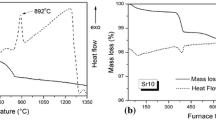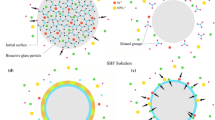Abstract
Silicate ions released from bioactive glasses and ceramics have been reported to stimulate osteogenic cell functions. Here, we evaluated osteoblast-like cell reactions to silicate ions released from two different types of materials, 45S5 bioactive glass (BG) and siloxane-doped vaterite (SiV), to investigate the influence of the ionic structure of silicate ions on osteoblast-like cell properties. BG and SiV powders were prepared by using melt-quenching and carbonation methods, respectively. Aminopropyltriethoxysilane was used as a siloxane source of SiV. MC3T3-E1 and SaOS-2 cells were cultured in media containing dissolved BG or SiV ions (10–50 ppm of Si). Cell proliferation (metabolic activity), differentiation (alkaline phosphatase activity) and mineralisation (Ca deposition) were examined. 29Si NMR spectra demonstrated that Q0,1 species and T0–3 species were released from BG and SiV, respectively. Proliferation and mineralisation of the two types of cells were influenced by silicate ions released from BG and SiV in a concentration-dependent manner. In particular, there were significant differences (P < 0.05) in the degree of proliferation and Ca deposition levels in SaOS-2 cells treated with dissolved BG and SiV ions. Furthermore, Ca deposition in SaOS-2 cells was influenced by both the presence of silicate ions and the duration of exposure of cells to them. The structure of silicate ions influenced the proliferation and mineralisation of SaOS-2 cells incubated for different time periods in culture media containing different Si concentrations. Understanding the effect of Si on bone cell behaviour will enable a design-led approach to further BG optimisation.








Similar content being viewed by others
References
Hench LL (1998) Bioceramics. J Am Ceram Soc 81(7):1705–1727. doi:10.1111/j.1151-2916.1998.tb02540.x
Hench L (1980) Biomaterials. Science 208(4446):826–831. doi:10.1126/science.6246576
Neo M, Kotani S, Nakamura T, Yamamuro T, Ohtsuki C, Kokubo T, Bando Y (1992) A comparative study of ultrastructures of the interfaces between four kinds of surface-active ceramic and bone. J Biomed Mater Res 26(11):1419–1432. doi:10.1002/jbm.820261103
Li P, Ohtsuki C, Kokubo T, Nakanishi K, Soga N, Nakamura T, Yamamuro T (1992) Apatite formation induced by silica gel in a simulated body fluid. J Am Ceram Soc 75(8):2094–2097. doi:10.1111/j.1151-2916.1992.tb04470.x
Xynos ID, Edgar AJ, Buttery LDK, Hench LL, Polak JM (2000) Ionic products of bioactive glass dissolution increase proliferation of human osteoblasts and induce insulin-like growth factor II mRNA expression and protein synthesis. Biochem Biophys Res Commun 276(2):461–465. doi:10.1006/bbrc.2000.3503
Hoppe A, Güldal NS, Boccaccini AR (2011) A review of the biological response to ionic dissolution products from bioactive glasses and glass-ceramics. Biomaterials 32(11):2757–2774. doi:10.1016/j.biomaterials.2011.01.004
Li H, Chang J (2013) Bioactive silicate materials stimulate angiogenesis in fibroblast and endothelial cell co-culture system through paracrine effect. Acta Biomater 9(6):6981–6991. doi:10.1016/j.actbio.2013.02.014
Jiao K, Niu LN, Li QH, Chen FM, Zhao W, Li JJ, Chen JH, Cutler CW, Pashley DH, Tay FR (2015) Biphasic silica/apatite co-mineralized collagen scaffolds stimulate osteogenesis and inhibit RANKL-mediated osteoclastogenesis. Acta Biomater 19:23–32. doi:10.1016/j.actbio.2015.03.012
Jell G, Stevens MM (2006) Gene activation by bioactive glasses. J Mater Sci Mater Med 17(11):997–1002. doi:10.1007/s10856-006-0435-9
Zhou X, Moussa FM, Mankoci S, Ustriyana P, Zhang N, Abdelmagid S, Molenda J, Murphy WL, Safadi FF, Sahai N (2016) Orthosilicic acid, Si(OH)4, stimulates osteoblast differentiation in vitro by upregulating miR-146a to antagonize NF-κB activation. Acta Biomater 39:192–202. doi:10.1016/j.actbio.2016.05.007
Han P, Wu C, Xiao Y (2013) The effect of silicate ions on proliferation, osteogenic differentiation and cell signalling pathways (WNT and SHH) of bone marrow stromal cells. Biomater Sci 1(4):379–392. doi:10.1039/C2BM00108J
Pedone A, Charpentier T, Malavasi G, Menziani MC (2010) New insights into the atomic structure of 45S5 bioglass by means of solid-state NMR spectroscopy and accurate first-principles simulations. Chem Mater 22(19):5644–5652. doi:10.1021/cm102089c
Nakamura J, Poologasundarampillai G, Jones JR, Kasuga T (2013) Tracking the formation of vaterite particles containing aminopropyl-functionalized silsesquioxane and their structure for bone regenerative medicine. J Mater Chem B 1(35):4446–4454. doi:10.1039/c3tb20589d
Obata A, Tokuda S, Kasuga T (2009) Enhanced in vitro cell activity on silicon-doped vaterite/poly(lactic acid) composites. Acta Biomater 5(1):57–62. doi:10.1016/j.actbio.2008.08.004
Obata A, Hotta T, Wakita T, Ota Y, Kasuga T (2010) Electrospun microfiber meshes of silicon-doped vaterite/poly(lactic acid) hybrid for guided bone regeneration. Acta Biomater 6(4):1248–1257. doi:10.1016/j.actbio.2009.11.013
Fujikura K, Lin S, Nakamura J, Obata A, Kasuga T (2013) Preparation of electrospun fiber mats using siloxane-containing vaterite and biodegradable polymer hybrids for bone regeneration. J Biomed Mater Res Part B 101(8):1350–1358. doi:10.1002/jbm.b.32952
Kasuga T, Obata A, Maeda H, Ota Y, Yao X, Oribe K (2012) Siloxane-poly(lactic acid)-vaterite composites with 3D cotton-like structure. J Mater Sci Mater Med 23(10):2349–2357. doi:10.1007/s10856-012-4607-5
Jones JR, Tsigkou O, Coates EE, Stevens MM, Polak JM, Hench LL (2007) Extracellular matrix formation and mineralization on a phosphate-free porous bioactive glass scaffold using primary human osteoblast (HOB) cells. Biomaterials 28(9):1653–1663. doi:10.1016/j.biomaterials.2006.11.022
Shie M-Y, Ding S-J, Chang H-C (2011) The role of silicon in osteoblast-like cell proliferation and apoptosis. Acta Biomater 7(6):2604–2614. doi:10.1016/j.actbio.2011.02.023
Shen Y, Liu W, Wen C, Pan H, Wang T, Darvell BW, Lu WW, Huang W (2012) Bone regeneration: importance of local pH-strontium-doped borosilicate scaffold. J Mater Chem 22(17):8662–8670. doi:10.1039/c2jm16141a
de la Concepción Matesanz M, Feito MJ, Ramírez-Santillán C, Lozano RM, Sánchez-Salcedo S, Arcos D, Vallet-Regí M, Portolés M-T (2012) Signaling pathways of immobilized FGF-2 on silicon-substituted hydroxyapatite. Macromol Biosci 12(4):446–453. doi:10.1002/mabi.201100456
Tsigkou O, Jones JR, Polak JM, Stevens MM (2009) Differentiation of fetal osteoblasts and formation of mineralized bone nodules by 45S5 Bioglass® conditioned medium in the absence of osteogenic supplements. Biomaterials 30(21):3542–3550. doi:10.1016/j.biomaterials.2009.03.019
Obata A, Kasuga T (2009) Stimulation of human mesenchymal stem cells and osteoblasts activities in vitro on silicon-releasable scaffolds. J Biomed Mater Res Part A 91(1):11–17
Gough JE, Jones JR, Hench LL (2004) Nodule formation and mineralisation of human primary osteoblasts cultured on a porous bioactive glass scaffold. Biomaterials 25(11):2039–2046. doi:10.1016/j.biomaterials.2003.07.001
Christodoulou I, Buttery LDK, Saravanapavan P, Tai G, Hench LL, Polak JM (2005) Dose- and time-dependent effect of bioactive gel-glass ionic-dissolution products on human fetal osteoblast-specific gene expression. J Biomed Mater Res Part B 74(1):529–537. doi:10.1002/jbm.b.30455
Christodoulou I, Buttery LDK, Tai G, Hench LL, Polak JM (2006) Characterization of human fetal osteoblasts by microarray analysis following stimulation with 58S bioactive gel-glass ionic dissolution products. J Biomed Mater Res Part B 77B(2):431–446. doi:10.1002/jbm.b.30455
Xynos ID, Edgar AJ, Buttery LDK, Hench LL, Polak JM (2001) Gene-expression profiling of human osteoblasts following treatment with the ionic products of Bioglass® 45S5 dissolution. J Biomed Mater Res 55(2):151–157. doi:10.1002/1097-4636(200105)55:2<151:AID-JBM1001>3.0.CO;2-
Acknowledgements
This work was supported in part by JSPS KAKENHI Grant Number 26820304 and Izumi Science and Technology Foundation.
Author information
Authors and Affiliations
Corresponding author
Ethics declarations
Conflict of interest
The authors declare no conflict of interest associated with this manuscript
Rights and permissions
About this article
Cite this article
Obata, A., Iwanaga, N., Terada, A. et al. Osteoblast-like cell responses to silicate ions released from 45S5-type bioactive glass and siloxane-doped vaterite. J Mater Sci 52, 8942–8956 (2017). https://doi.org/10.1007/s10853-017-1057-y
Received:
Accepted:
Published:
Issue Date:
DOI: https://doi.org/10.1007/s10853-017-1057-y




